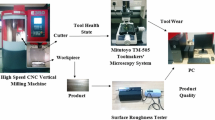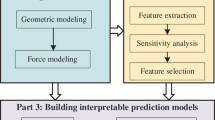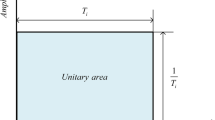Abstract
Computer-aided manufacturing (CAM) software outputs machining data by encoding a tool-path into a series of G-codes which are composed of various lengths of line segments. The discontinuities of these line segments may cause inefficiency for computer numerical control (CNC) system. To achieve high-speed continuous motions, corner smoothing algorithms based on look-ahead methods are widely used. However, it is difficult to meet smoothing trajectories in real-time requirements. Based on machine learning method, in this paper, a support vector machine (SVM) system is presented for directly outputting classification results of the various geometric continuities at the transition corners. The feature values used for generating continuity classification model are extracted from sampling paths of the previous publication work: the machining parameters, length, fairness criteria, the root mean square (RMS) contour errors, and dominant stage type of movement of each sampling path are calculated. The acceleration/deceleration (ACC/DEC) feedrate planning scheme is used to determine the feedrate at the transition corners. Simulations and experiments show that the proposed algorithm can realize accurately and efficiently continuity classification in real-time requirements under the conditions of machining accuracy.




















Similar content being viewed by others
Data availability
All data generated or analyzed during this study are included in this published article.
References
Tsai MS, Nien HW, Yau HT (2010) Development of a real-time look-ahead interpolation methodology with spline-fitting technique for high-speed machining. Int J Adv Manuf Technol 47:621–638
Yau HT, Wang JB (2007) Fast Bezier interpolator with real-time lookahead function for high-accuracy machining. Int J Mach Tool Manu 47:1518–1529
Pateloup V, Duc E, Ray P (2010) Bspline approximation of circle arc and straight line for pocket machining. Comput Aided Des 42(9):817–827
Pessoles X, Landon Y, Rubio W (2010) Kinematic modelling of a 3-axis NC machine tool in linear and circular interpolation. Int J Adv Manuf Technol 47:639–655
Farouki RT, Tsai YF (2001) Exact Taylor series coefficients for variable-feedrate CNC curve interpolators. Comput Aided Des 42:155–165
Tajima S, Sencer B (2017) Global tool-path smoothing for CNC machine tools with uninterrupted acceleration. Int J Mach Tools Manuf 121:81–95
Beudaert X, Lavernhe S, Tournier C (2013) 5-Axis local corner rounding of linear tool path discontinuities. Int J Mach Tools Manuf 73:9–16
Yeh SS, Hsu PL (1999) The speed-controlled interpolator for machining parametric curves. Comput Aided Des 31(5):349–357
Zhang Q, Greenway RB (1998) Development and implementation of a NURBS curve motion interpolator. Robot Comput Integr Manuf 14:27–36
Cheng MY, Tsai MC, Kuo JC (2002) Real-time NURBS command generators for CNC servo controllers. Int J Mach Tools Manuf 42:801–813
Yang MY, Park JH (2002) A study on a open architecture CNC system with a NURBS interpolator for WEDM. Int J Adv Manuf Technol 19:664–668
Lin RS (2000) Real-time surface interpolator for 3-D parametric surface machining on 3-axis machine tools. Int J Mach Tools Manuf 40:1513–1526
Yong T, Narayanaswami R (2003) A parametric interpolator with confined chord errors, acceleration and deceleration for NC machining. Comput. Aided Des 35:1249–1259
Tsai MC, Cheng CW, Cheng MY (2003) A real-time NURBS surface interpolator for precision three-axis CNC machining. Int. J. Mach. Tool Manuf 43:1217–1227
Cheng MY, Tsai MC, Kuo JC (2002) Real-time NURBS command generators for CNC servo controllers. Int J Mach Tools Manuf 42(7):801–813
Li BR, Zhang H, Ye PQ, Wang JS (2020) Trajectory smoothing method using reinforcement learning for computer numerical control machine tools. Robot CIM-Int Manuf 61
Sun S, Lin H, Zheng L, Yu J, Hu Y (2016) A real-time and look-ahead interpolation methodology with dynamic B-spline transition scheme for CNC machining of short line segments. Int J Adv Manuf Technol 84:1359–1370
Yong Z, Zhao MY, Ye P, Zhang H (2019) A G4 continuous B-spline transition algorithm for CNC machining with jerk-smooth feedrate scheduling along linear segments. Comput Aided Des 115:231–243
Dittrich MA, Uhlich F, Denkena B (2019) Self-optimizing tool path generation for 5-axis machining processes. CIRP J Manuf Sci Technol 24:49–54
Yen SS, Hsu PL (2002) Adaptive-feedrate interpolation for parametric curves with a confined chord error. Comput Aided Des 34(3):229–237
Zhou B, Zhao JB, Li L, Xia RB (2016) NURBS curve interpolation algorithm based on tool radius compensation method. Int J Prod Res 54(15):4448–4474
Morgan H, Druckmuller M (2014) Multi-scale Gaussian normalization for solar image processing. Sol Phys 8:2945–2955
Emami MM, Arezoo B (2010) A look-ahead command generator with control over trajectory and chord error for NURBS curve with unknown arc length. Comput Aided Des 42:625–632
Floater MS, Rasmussen AF (2006) Point-based methods for estimating the length of a parametric curve. J Comput Appl Math 196(2:512–522
Sapidis N, Farin G (1990) Automatic fairing algorithm for B-spline curves. Comput. Aided Des 22:12–19
Sapidis N (1987) Designing fair curves and surfaces: shape quality in geometric modeling and computer-aided design. Geometric design publications, Athens
Boser B.E., Guyon I, Vapnik V (2008) A training algorithm for optimal margin classifiers. Proceedings, 2008, the fifth annual workshop on computational learning theory. ACM, pp 192: 144–152
Markowska KU, Kubacki P (2005) Support vector machines in handwritten digits classification. Proceedings, 2005, 5th international conference on intelligent systems design and applications
Chen T, Ju SH, Ren FJ, Fan MY, Gu Y (2020) EEG emotion recognition model based on the LIBSVM classifier. Measurement 164(5). https://doi.org/10.1016/j.measurement.2020.108047
Waltona D, Meekb D (2009) G2 blends of linear segments with cubics and Pythagorean-hodograph quintics. Int J Comput Math 86(9):1498–1511
Funding
The authors are grateful for the support provided by National Key Research and Development Project (grant no. 2018YFB1105300), National Natural Science Foundation of China (grant no. 51605475) and The central government guides the local science and technology development fund plan (grant no. 2021JH6/10500123).
Author information
Authors and Affiliations
Contributions
Bo Zhou performed the algorithm design, code writing, and was a major contributor in writing the manuscript. Tongtong Tian analyzed and interpreted the experimental data. Jibin Zhao presented the experimental site and equipment, and proposed the revise opinions. Dianhai Liu corrected the grammars of the revised manuscript. All authors read and approved the final manuscript.
Corresponding authors
Ethics declarations
Ethics approval
Not applicable.
Consent to participate
Not applicable.
Consent to publish
Not applicable.
Competing interests
The authors declare no competing interests.
Additional information
Publisher’s note
Springer Nature remains neutral with regard to jurisdictional claims in published maps and institutional affiliations.
Rights and permissions
About this article
Cite this article
Zhou, B., Tian, T., Zhao, J. et al. Tool-path continuity determination based on machine learning method. Int J Adv Manuf Technol 119, 403–420 (2022). https://doi.org/10.1007/s00170-021-08156-2
Received:
Accepted:
Published:
Issue Date:
DOI: https://doi.org/10.1007/s00170-021-08156-2




